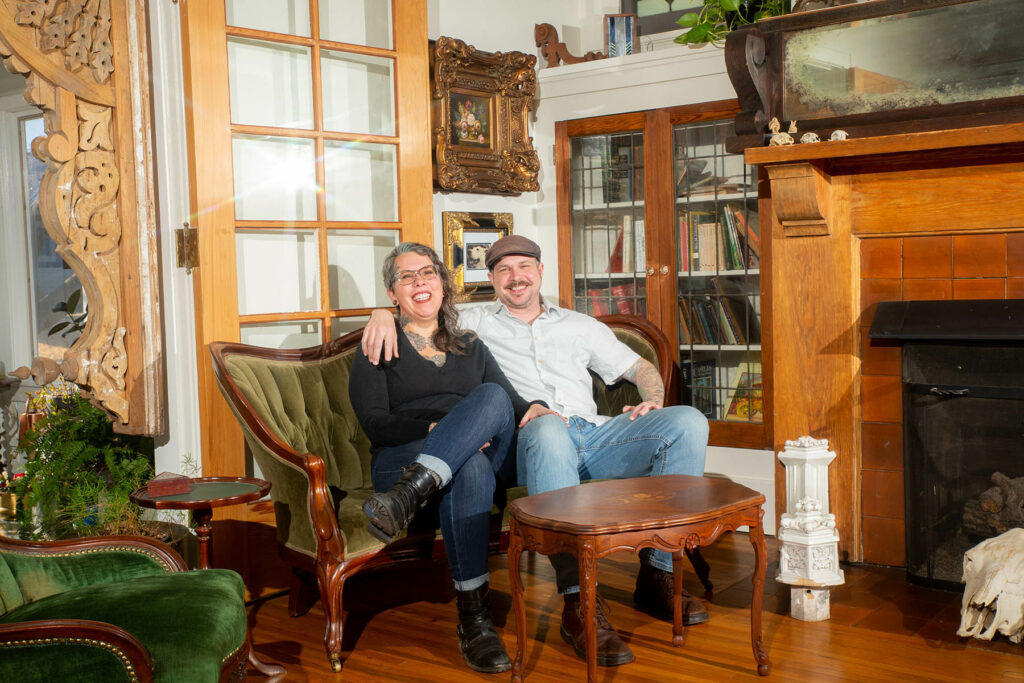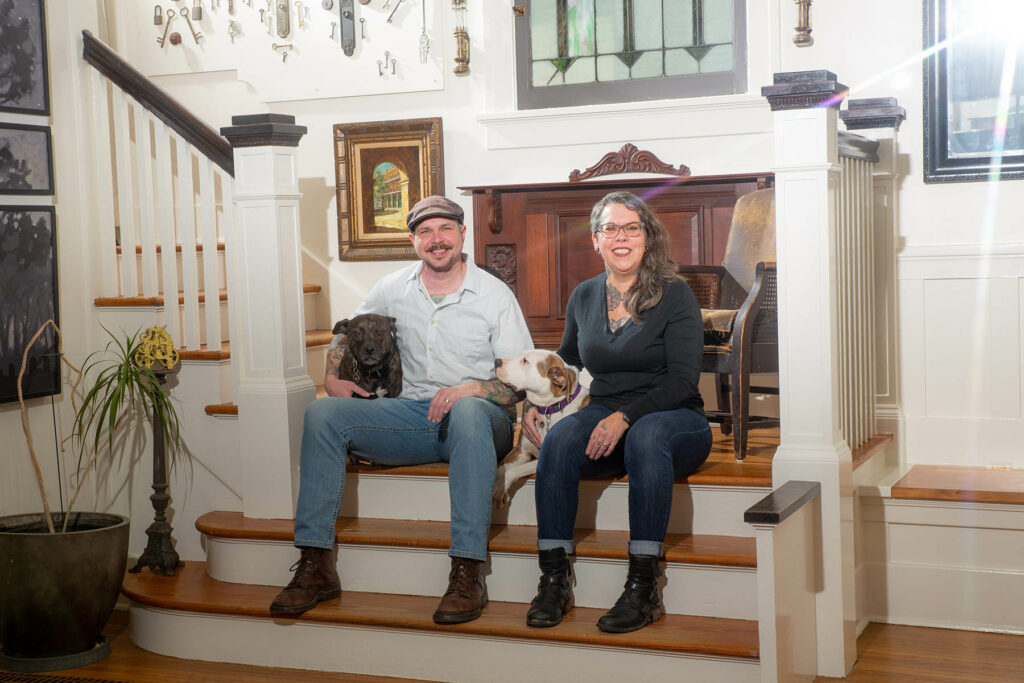story by Chris Reeder Young | photos by Marcus Menefee
Memphis is blessed with two business creatives who form one of my most favorite and inspiring couples. They make big differences in very important spaces. Angela Russell, who owns Underground Art, Inc, and Cristofir Bradley, a custom cabinet maker, exude power couple vibes. Their generosity, skillfulness, inclusivity, and their authentic commitments and innovations are assets to our collective creative communities.
They have navigated very different types of industries which are both, however, fairly saturated with toxic masculinity and close-mindedness (tattoo shops and construction). Their journey, individually and together as native Memphians, has formed an authentic and joyful path that elevates their sectors and better serves Memphis through inclusive and compassionate leadership.
TATTOO SHOPS AND EXPECTATIONS: ANGELA
As a southern teen who was interested in piercings and tattoos, my only option in central Alabama was a skeezy tattoo shop run by a guy named Insanity who had never heard of a public health rating. Going in to a place like that was intimidating, thick with discrimination, and thin on body art options that fit what I wanted. It wasn’t until I went to Underground Art and met Angela that I realized that I didn’t have to sacrifice my comfort as a woman if I wanted body modifications. I had never heard of shops being led by women, and I didn’t realize that shops could be so inclusive of people who were like me or like people I loved in the LGBTQA+ community. Getting to know Angela and the shop are some of my most favorite memories as a newcomer to Memphis in 2005.
What are Underground Art’s origins and evolutions?
When I discovered tattooing, it was just hitting its renaissance. So, when I had the opportunity to open the shop, it was great timing. I opened up in 1993, and we were the first custom shop in the city. UGA being a custom shop meant that we didn’t have pre-made flash on the walls, rather tattoo artists created art and designs specific and unique to the client. We were always slammed with clients, and we trained many artists who ended up branching out on their own. We survived the 2007 recession while staying relevant through custom work that kept the art and artists as the most important things to keep us going. Keeping our finger on that particular pulse is what the community wanted and responded to the best so we could stay open.
Why is it important for UGA to be inclusive?
When we opened, the only shops in Memphis were biker shops. Nothing against bikers, but that culture isn’t known for its inclusivity. It was very important to me that we make sure that every person felt at ease and that meant that I needed to hire people who are very good at creating a comfortable and welcoming environment. For me, at that time, that inclusion was more centered around Black and Brown people, as we grew and evolved we wanted to cast that net wider, to create an inclusive space for all underserved and marginalized people. At the time, there were very few women tattoo artists. A friend of mine, Jennifer Billig, and I would go to tattoo conventions and that really showed me what it could be like for there to be more women. Weren’t a bunch of us back then! People come in, and they are already nervous because body modification can hurt. We create this space inside the UGA shop that raises the bars for what to expect and how best to meet people where they are. This draws people from the outside who come to this safe space for art. A gesture like asking a person their pronouns or their preferred name helps them feel seen and calm. They never have to worry about being stared at, or made fun of or getting the nudges or winks that some non-binary or LGBTQA+ folx can get out in public. We treat people with respect wherever they are.

How does being inclusive help wellbeing for queer tattoo artists?
I think that it helps to give them a place to be themselves; it’s important to feel safe and at ease when you’re doing tattoo work or getting tattoo work. For queer tattoo artists, people do their best work when they feel at ease and feel like they are in their safest environments. We didn’t set out to find artists who identified Trans or non-binary specifically. The focus is on the art, not the identity; but, we just happen to know great artists who were a good fit for the shop and our affirming environment drew them here. We have a huge clientele that is non-binary and/or neurodivergent and our artists are very welcoming and good at meeting them where they are. We lucked into so many people who work here and are so great.
What are some of your dreams and hopes for UGA?
I would like to see the shop move into a larger space where we can offer all kinds of art, maybe drawing workshops too. I hope to be able to move the shop into
more healing spaces as well. It’s important to me that we give back as much as possible in this community and raise awareness around social justice issues. We
have hosted events to raise awareness for mental health issues, Trans issues, literacy, Black Lives Matter, and we hope to do a lot more of that going forward.
What’s your favorite thing about your spouse?
I really thought about this question, it’s so hard to parse out one thing. Cristofir is my home, he is where I go when I feel scared or anxious, and he is where I go to celebrate victories. He is where I go to laugh and cry and say crass things. He is my touchstone and my ballast and my lighthouse and every other metaphor that means safety and stability. He’s all of that wrapped in a smokin’ hot package.
CONSTRUCTION SPACES: CRISTOFIR
I met Cristofir through Angela about 15 years ago and was consistently impressed by how someone can take a piece of tree and turn it into a beautifully crafted functional item that people can use and enjoy daily. As a southerner, I had only seen woodworking transformations like that at a distance where women and non-binary people haven’t always be present, engaged, or celebrated. It was like the outdated school tradition of girls being sent to home economics to sew things and boys being sent to shop class to build things still resonated loudly in contemporary construction industries. Cristofir’s personal journey, how he has navigated such a culturally-exclusive industry, is important for others to hear about and reveals what makes tree-to-cabinet making so special (especially in southern spaces).
What led you to woodworking?
My dad was a cabinet maker and I saw him work, but the knowledge and interest I gained was through observation. I always like making things and building stuff. I went into construction when I was 19 before I transitioned, and it felt pretty badass. I’m a perfectionist, and I went from rough construction work, to being a framer, to doing trim carpentry, and then to cabinetry. I was getting more and more refined in the work, and I’m best suited for that.

How do you get to manifest your creative side as a woodworker?
I don’t necessarily consider myself an art maker, but I do the type of woodworking where I get to engage with people and make their dreams come true by turning creative ideas into a physical reality. I’ve always felt compelled to make something. When I’m not woodworking, I like to cook elaborate things. I love to be faced with creating something that has a lot of restrictions and see what I can do, like renovating UGA with my wife. We were all on lockdown so we didn’t have the ability to shop, so we used found items and things I already had at my own shop. I don’t think of myself as an artist, I just like to make things.
Do non-binary/LGBTQ+ folk have challenges accessing carpentry training? What’s a solution?
This work is blue collar work in the south, so there are assumptions when it comes down to gender and identity that are different for cis-hetero men. Before, I put up with so much stuff because I just wanted to make things. Some guys were comfortable in their own masculinity and taught me solid and important worksite things back then, but they were few and far between. This is an all-boys network. There are some honest good guys who may not know how to act, just may not have had an opportunity to exchange with queers. I transitioned on a construction site while I was renovating houses in New Orleans. It was dramatic; I worked for one crew, started T, and then went to another crew as my new self. I immediately got a 30% pay increase. I was considered more competent as soon as I started to be perceived as male like it was day and night after my transition. Since transitioning, it’s been something to see how lucky white men have it. It is also so freeing to just work and be yourself and not have to defend your gender or identity so you can just focus on the work and helping clients. For newcomers, there are women woodworkers out there, find them and connect to them if you’re a non-binary person or LGBTQA+ interested in getting into the field.
What are some of your dreams and hopes for your career?
My hope for my business is that I get to continue to live my dream. I just want to keep making beautiful things for people, and continue making intentional decisions to keep earning a living and never make a dollar at the expense of some other’s well being or only for the sake of capitalism. I like perfecting my craft and hope to get into more hand tool work for fun.
What’s your favorite thing about your spouse?
She’s so quietly radical and does so much to help others and the community, and local organizations. She never turns down donating to others. She is so humble and has done so much good in the world to raise awareness about things too. She also won’t take any BS!
Advice from A and C: Try to cast the network wide on anything that you’re trying to get into. Be inclusive and welcoming and focus on the creative works.



